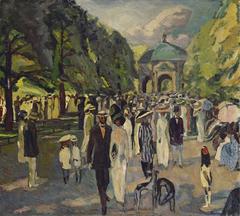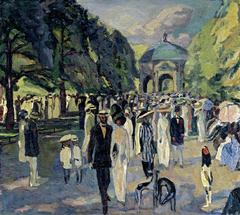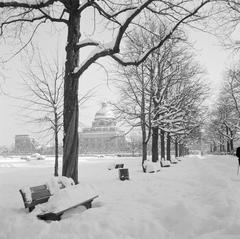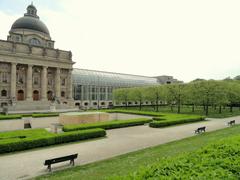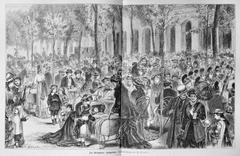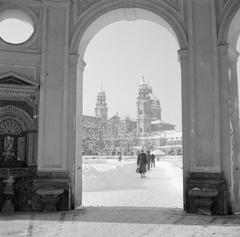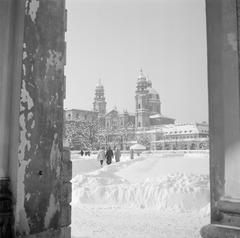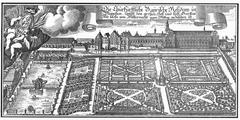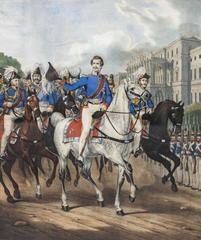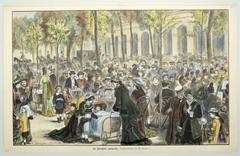
Hofgarten Munich: Visiting Hours, Tickets, and Guide to Munich’s Historic Court Garden
Date: 14/06/2025
Introduction
Situated in the very heart of Munich, the Hofgarten stands as a testament to Renaissance artistry, Bavarian history, and the city’s enduring appreciation for green, communal spaces. Originally commissioned as a private retreat for the Bavarian royal family in the early 17th century, it now serves as a beloved public park, offering visitors a tranquil escape amid the city’s vibrant urban life. This detailed guide will cover everything you need to know about the Hofgarten Munich, including its visiting hours, ticket information, historical background, architectural highlights, accessibility, and practical travel tips—making it an essential resource for anyone planning a visit to Munich’s historic center.
Table of Contents
- Introduction
- Historical Overview
- Visiting the Hofgarten Munich
- Architectural and Artistic Highlights
- Activities and Events
- Seasonal Considerations
- Integration with Munich Itineraries
- Sustainability and Responsible Tourism
- FAQ
- Visual and Interactive Elements
- Conclusion and Call to Action
- References
Historical Overview
Origins and Early Development
Commissioned between 1614 and 1615 by Duke Maximilian I, the Hofgarten was designed as the court garden for the Munich Residenz, the royal palace of the Wittelsbach dynasty. Drawing inspiration from Italian Renaissance gardens, its layout features symmetrical parterres, geometric pathways, and a strong sense of axial order, reflecting the era’s ideals of harmony, perspective, and cultivated beauty (munich-info.info, muenchen.de).
The garden’s central landmark, the Dianatempel (Diana Temple), is a twelve-sided pavilion completed in 1615. This elegant structure quickly became the focal point of the Hofgarten, crowned with the bronze statue “Tellus Bavarica,” symbolizing Bavaria’s prosperity and agricultural richness (absolutemunich.com).
Evolution and Restoration
Throughout its 400-year history, the Hofgarten has evolved in response to changing tastes and political developments. While the Renaissance layout remained largely preserved, the garden saw Baroque and Enlightenment influences through new plantings and ornamental features. In the 19th century, as Munich modernized, the Hofgarten transitioned from an exclusive royal enclave to a public park—mirroring broader European trends toward democratizing green spaces (munich-info.info).
Severely damaged during World War II, the Hofgarten was meticulously restored using historical drawings and plans. Today, it stands as a living museum of landscape architecture and a symbol of Munich’s resilience and commitment to cultural heritage (absolutemunich.com).
Visiting the Hofgarten Munich
Hours and Tickets
- Opening Hours: The Hofgarten is open daily, generally from dawn until dusk. There are no locked gates, so visitors may enjoy the garden at their leisure, though it is safest and most pleasant to visit during daylight.
- Tickets: Admission is free; no tickets are required at any time (muenchen.de).
Directions and Accessibility
- Location: Between Munich Residenz and the Englischer Garten; adjacent to Odeonsplatz.
- Public Transport: The Odeonsplatz U-Bahn station (lines U3, U4, U5, U6) is just steps from the main entrance. Several bus and tram routes also serve the area (Wikipedia).
- By Car: Limited parking is available nearby; using public transport is recommended due to central city traffic.
- Accessibility: The garden features flat, paved paths suitable for wheelchairs, strollers, and those with mobility challenges. Dogs are permitted if leashed (Munich Travel).
Visitor Tips
- Best Times: Early mornings and late afternoons offer a quieter, more peaceful atmosphere. Shoulder seasons (April-May, October-November) are less crowded (Xplrverse).
- Amenities: Benches throughout the garden, nearby cafés and restaurants (especially around Odeonsplatz), and public restrooms in adjacent areas.
- Weather: Munich’s weather is variable; bring layers and rain gear, especially in spring and autumn.
Architectural and Artistic Highlights
Dianatempel (Diana Temple)
At the garden’s center, the Dianatempel serves as both an architectural and social focal point. The twelve-sided pavilion is open on eight sides and houses four shell-shaped fountains. Topped by a bronze allegorical statue, the Dianatempel is a favored spot for impromptu music performances and summer concerts (absolutemunich.com, explorial.com).
Arcades and Frescoes
The northern and western sides of the Hofgarten are lined with arcades, creating covered walkways that protect visitors in all weather. These arcades feature frescoes depicting scenes from Bavarian history, particularly the Wittelsbach dynasty’s legacy (muenchen.de). The western arcade’s murals, painted by students of Peter Cornelius, are a highlight for art enthusiasts (munich.travel).
Monuments and Memorials
- Kriegerdenkmal: A war memorial honoring Munich residents who died in World War I; located before the Bavarian State Chancellery (absolutemunich.com).
- White Rose Memorial: Commemorates members of the anti-Nazi resistance group.
- Loreley Statue: Near the arcade, this statue references German folklore (Destination Munich).
- Orlando di Lasso Monument: Celebrating the composer’s contribution to Bavarian music (explorial.com).
Activities and Events
- Strolling and Relaxation: The Hofgarten is ideal for leisurely walks, reading, or enjoying a coffee on a bench.
- Cultural Performances: The Dianatempel frequently hosts live music—classical ensembles, jazz bands, and even tango dancers in summer months (explorial.com).
- Boule/Boccia: Locals often play boules or boccia on the gravel paths, lending a lively, communal atmosphere (muenchen.de).
- Museums: The Deutsche Theatermuseum is located in the garden’s northern arcade, offering exhibitions on theatre history (Destination Munich).
Seasonal Considerations
- Spring: Flowerbeds are in full bloom; crowds are fewer.
- Summer: Bustling with performances and picnics.
- Autumn: Foliage turns golden; the park is tranquil.
- Winter: The garden is quieter, with nearby Christmas markets adding festive cheer (Xplrverse).
Integration with Munich Itineraries
The Hofgarten’s central location makes it a convenient stop between major attractions such as the Munich Residenz, Theatinerkirche, Bavarian State Chancellery, and the Englischer Garten. It’s equally suitable for a quick break during sightseeing or as part of a full-day cultural itinerary (Munich Travel).
Sustainability and Responsible Tourism
Munich maintains the Hofgarten as part of its commitment to green urban spaces and sustainable tourism. Visitors are encouraged to respect the park’s tranquility, keep dogs leashed, and dispose of litter responsibly (Xplrverse).
FAQ
Q: Is there an entrance fee for the Hofgarten Munich?
A: No, entry is free year-round.
Q: What are the Hofgarten’s opening hours?
A: The garden is open from dawn to dusk, with slight seasonal variation.
Q: Is the Hofgarten wheelchair accessible?
A: Yes, flat, paved paths accommodate wheelchairs and strollers.
Q: Can I bring my dog?
A: Yes, dogs are permitted if kept on a leash.
Q: How do I reach the Hofgarten by public transport?
A: Odeonsplatz U-Bahn station is the nearest stop.
Q: Are guided tours available?
A: Yes, many local operators and city tours include the Hofgarten (timeout.com).
Visual and Interactive Elements
To enrich your visit, explore virtual tours and photo galleries online. Key visual highlights include the Dianatempel, frescoed arcades, and panoramic views of the symmetrical garden layout. Optimized alt text such as “Hofgarten Munich visiting hours - Dianatempel” can improve your trip planning and search experience (Trip.com).
Conclusion and Call to Action
The Hofgarten Munich is a living blend of history, culture, and natural beauty—offering free access, year-round appeal, and a central location in the city’s historic core. Whether you’re seeking quiet reflection, cultural enrichment, or a scenic backdrop for photography, the Hofgarten delivers an experience that is both timeless and truly Bavarian.
For more travel insights, seasonal tips, and interactive guides to Munich’s cultural treasures, follow us on social media and download the Audiala app. Begin your journey at the Hofgarten and discover the harmonious mix of past and present that defines Munich.
References and Further Reading
- Hofgarten Munich Visiting Hours, Tickets, and Historical Guide – munich-info.info
- Hofgarten Munich: Visiting Hours, Tickets, and Architectural Highlights – absolutemunich.com
- Hofgarten Munich: Visiting Hours, Tickets, and Cultural Insights – muenchen.de
- Hofgarten Munich Visiting Hours, Tickets, and Guide to Munich’s Historic Court Garden – destination-munich.com
- Wikipedia: Hofgarten (Munich)
- Munich Travel: Itinerary Suggestions
- Trip.com: Hofgarten Moments
- Timeout: Munich Travel Tips
- Explorial: Munich Hofgarten
- Munich Travel: Hofgarten
